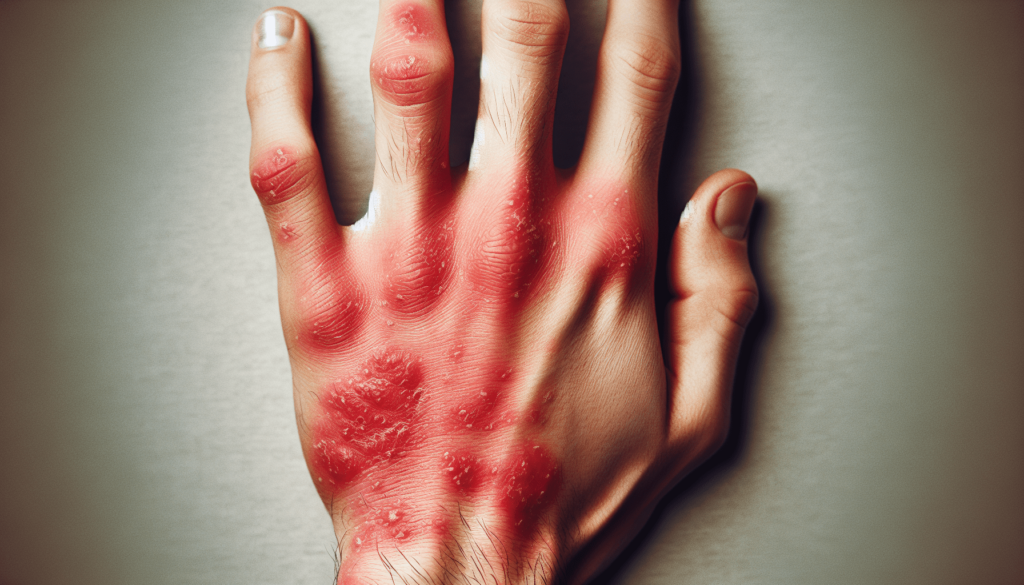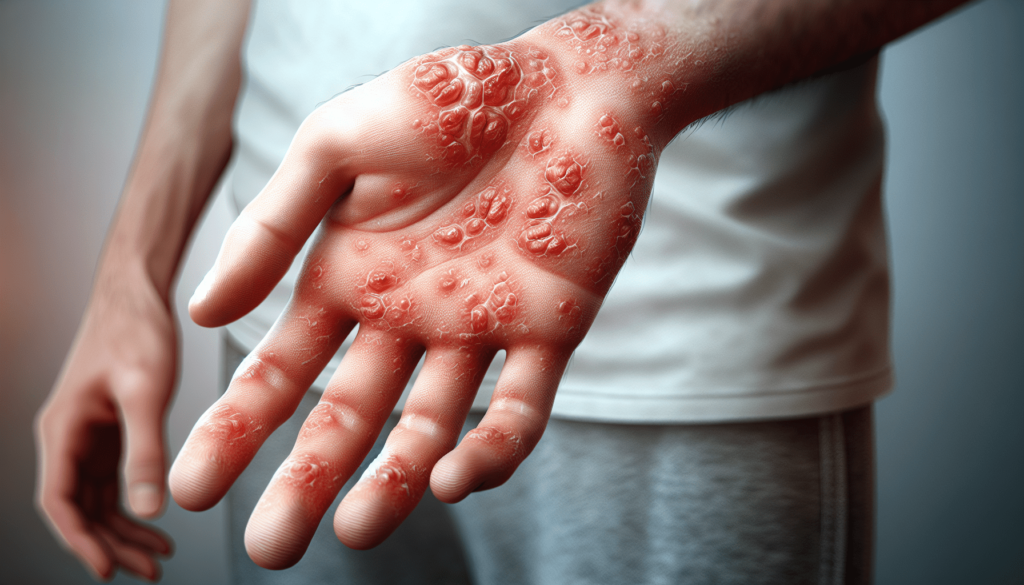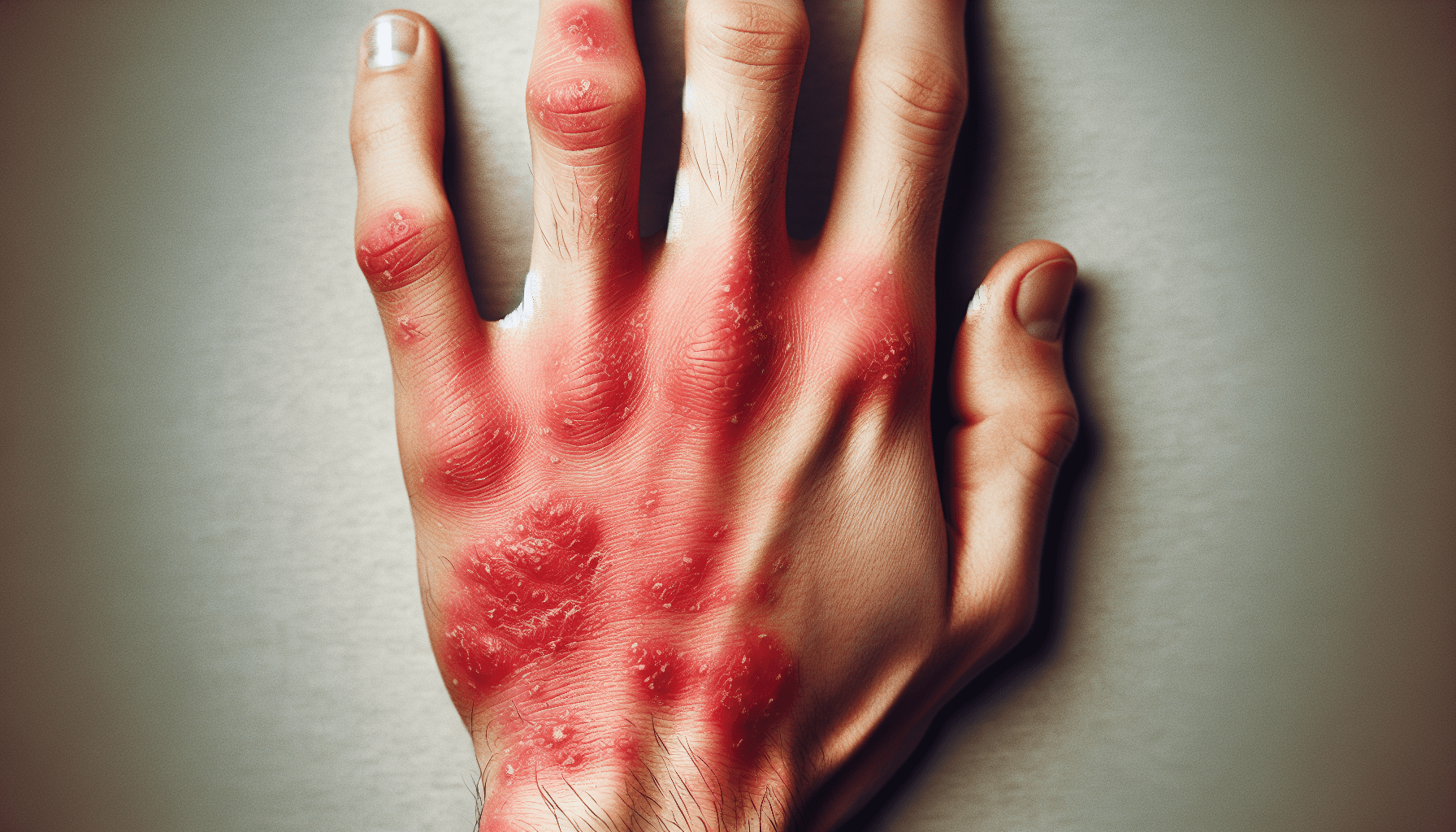Have you ever noticed an itchy, red, or inflamed patch on your skin and wondered what might have caused it? You are not alone; many people experience similar symptoms without knowing the cause. These symptoms could be a result of contact dermatitis, a common skin condition.

What is Contact Dermatitis?
Contact dermatitis is a type of skin inflammation that occurs when your skin comes into contact with an irritant or an allergen. It can affect anyone at any age and can occur anywhere on your body. Though not life-threatening, it can be uncomfortable and sometimes even embarrassing.
Types of Contact Dermatitis
To understand contact dermatitis better, you need to know that there are two primary types: irritant contact dermatitis and allergic contact dermatitis.
Irritant Contact Dermatitis
This is the most common type and occurs when your skin is exposed to substances that directly damage the outer layer of your skin. Often, repeated exposure to mild irritants can also lead to this condition. Common irritants include:
- Soaps
- Detergents
- Cleaning products
- Industrial chemicals
Allergic Contact Dermatitis
This type occurs when your skin comes into contact with a substance that causes an allergic reaction. This isn’t about damage to the skin’s outer layer but a response from your immune system. Some common allergens are:
- Nickel
- Poison ivy or poison oak
- Latex
- Certain fragrances and preservatives in cosmetics and skincare products
Symptoms of Contact Dermatitis
The symptoms of contact dermatitis can vary depending on the severity and the type of contact dermatitis you have. The classic symptoms include:
- Red rash or bumps
- Itching, which may be severe
- Swelling
- Dry, cracked, or scaly skin
- Blisters that may ooze or crust over
- Burning or stinging sensation
Differences Between Irritant and Allergic Contact Dermatitis
Both irritant and allergic contact dermatitis display similar symptoms, but a few subtle differences can help you identify which type you might have.
| Symptom | Irritant Contact Dermatitis | Allergic Contact Dermatitis |
|---|---|---|
| Onset Time | Immediate or delayed (within hours) | Delayed, appearing a few hours to days later |
| Pattern | Localized to the area in contact with the irritant | Can extend beyond the initial contact area |
| Common Sites | Hands, forearms | Any area exposed to the allergen |
Causes of Contact Dermatitis
Understanding the causes can help identify and manage the symptoms more effectively.
Common Irritants
As mentioned earlier, irritant contact dermatitis is often caused by substances that physically damage your skin. Here’s a more in-depth look at some common irritants:
- Soaps and Detergents: These can strip away natural oils, leaving your skin more vulnerable.
- Cleaning Agents: Ingredients in household and industrial cleaners can cause damage with prolonged or repeated use.
- Chemicals: Certain chemicals in workplaces, such as those in painting or printing industries, pose a risk.
- Water: Prolonged exposure to water, particularly if it is hard or chlorinated, can be an irritant.
Common Allergens
Allergic contact dermatitis is elicited through an immune response. Here’s more about common allergens:
- Nickel: Found in jewelry, belt buckles, zippers, and even some cell phones.
- Plants: Poison ivy, poison oak, and poison sumac contain urushiol, which is a potent allergen.
- Latex: Common in gloves, balloons, and various medical equipment.
- Fragrances and Preservatives: Found in cosmetics, perfumes, and personal care products, these are common triggers.
Occupational Exposure
Certain occupations put individuals at a higher risk of developing contact dermatitis due to the frequent exposure to potential irritants and allergens. Here are a few examples:
- Healthcare workers due to constant glove use and disinfectants
- Hairdressers exposed to dyes and shampoos
- Cleaners frequently handling cleaning agents
- Construction workers handling various materials and chemicals
Diagnosis of Contact Dermatitis
Understanding how contact dermatitis is diagnosed can be essential for effective treatment.
Medical History and Physical Examination
Your healthcare provider will start with a thorough medical history and physical examination. You may be asked:
- When did the symptoms start?
- What substances has your skin come into contact with?
- Have you recently started using any new products?
Patch Testing
For allergic contact dermatitis, patch testing is often conducted to identify the specific allergen. Small quantities of potential allergens are applied to your skin and covered with patches. After 48 hours, the patches are removed to see which substances cause a reaction.

Treatment of Contact Dermatitis
Properly treating contact dermatitis can alleviate symptoms and prevent recurrence.
Topical Treatments
One of the most common treatment methods involves topical treatments, including:
- Steroid Creams or Ointments: These reduce inflammation and itching. Over-the-counter options are available, but stronger versions may require a prescription.
- Moisturizers: Keeping the skin hydrated can help to repair the skin barrier.
Oral Medications
In more severe cases, your healthcare provider may prescribe oral medications:
- Antihistamines: These can help to relieve itching.
- Corticosteroids: These are prescribed for severe inflammation and are generally short-term treatments.
Avoidance of Triggers
A preventive approach is often required in managing contact dermatitis:
- Identify and Avoid Irritants/Allergens: Patch testing can help you understand what to avoid.
- Protective Gear: Wear gloves or protective clothing if contact with the irritant/allergen is unavoidable.
- Routine Skin Care: Regular use of hypoallergenic moisturizers and gentle cleansers can help.
Home Remedies
Some simple home remedies can offer relief:
- Cold Compresses: Applied to affected areas to relieve itching and reduce swelling.
- Oatmeal Baths: Colloidal oatmeal can soothe irritated skin.
Prevention of Contact Dermatitis
Preventing contact dermatitis is a more manageable task when you are equipped with the right knowledge.
General Tips
Here are some strategies you can adopt to avoid irritants and allergens:
- Read Labels: Being aware of the ingredients in your skincare and household products can help to avoid known irritants and allergens.
- Patch Test New Products: Before using a new cosmetic or skincare product, test it on a small area of your skin to ensure it doesn’t cause a reaction.
- Workplace Safety: Ensure that your workplace follows protocols for reducing skin exposure to hazardous substances.
Protective Measures in Specific Scenarios
At Work
In occupational settings, adopting protective measures is crucial:
- Protective Clothing: Use gloves and long sleeves when handling chemicals.
- Barrier Creams: These can provide an additional layer of protection for your skin.
At Home
At home, simple adjustments can make a big difference:
- Mild Detergents: Choose laundry and dishwashing detergents labeled as hypoallergenic.
- Moisturizers: Keeping your skin hydrated can enhance its barrier function.
Understanding Severity and When to See a Doctor
Understanding the severity of your symptoms can help determine when you should seek professional advice.
Mild vs. Severe Contact Dermatitis
Mild contact dermatitis might present as localized redness and mild itching, while severe cases can include extensive rashes, severe itching, swelling, and even blisters.
| Severity | Symptoms | Action |
|---|---|---|
| Mild | Localized redness, mild itching | Over-the-counter treatments, home remedies |
| Moderate | Widespread rash, considerable itching | Consult a healthcare provider |
| Severe | Extensive rash, severe itching, swelling, blisters | Immediate medical attention |
When to Consult a Healthcare Provider
You should seek medical advice if:
- Over-the-counter treatments are ineffective.
- The rash covers a large portion of your body.
- You experience severe itching or swelling.
- You develop blisters that ooz or crust over.
- Your symptoms are worsening or not improving.
Understanding the Impact of Contact Dermatitis on Quality of Life
Beyond the physical symptoms, contact dermatitis can have emotional and psychological impacts as well.
Emotional and Psychological Impacts
Persistent itching, rash, and swelling can be distressing. Over time, these symptoms can lead to:
- Social Withdrawal: Avoiding social situations due to visible skin issues.
- Self-consciousness: Feeling embarrassed or anxious about your appearance.
- Sleep Disturbances: Severe itching can affect sleep quality.
Managing Emotional Well-being
Addressing the emotional aspects involves both medical treatment and emotional support:
- Support Groups: Connecting with others who have similar conditions can provide emotional support and practical advice.
- Professional Help: Consulting a therapist or counselor if you find the emotional toll overwhelming.
FAQs About Contact Dermatitis
Here are some frequently asked questions to further enhance your understanding of contact dermatitis.
Can Contact Dermatitis be Cured?
While there isn’t a permanent cure, symptoms can often be managed effectively through treatment and avoidance strategies.
Is Contact Dermatitis Contagious?
No, contact dermatitis is not contagious and cannot be spread from person to person.
Can Diet Affect Contact Dermatitis?
There isn’t specific evidence to suggest that diet directly affects contact dermatitis. However, maintaining overall skin health through a balanced diet can be beneficial.
Is Contact Dermatitis Age-related?
No, it can occur at any age, although some specific causes might be more common in certain age groups.
Can Pets Cause Contact Dermatitis?
Yes, pet dander and saliva can sometimes be allergens that trigger allergic contact dermatitis.
Final Thoughts
Understanding contact dermatitis is the first step in managing this condition effectively. By recognizing the symptoms, identifying the causes, and seeking appropriate treatments, you can significantly improve your quality of life. Remember, the key to managing contact dermatitis lies in combining prevention, appropriate treatment, and emotional well-being. If in doubt, consult a healthcare provider to get personalized advice suited to your specific condition. With the right knowledge and actions, you can keep contact dermatitis under control and focus on enjoying a comfortable and confident life.
